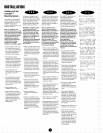
because of differences in the acoustical setting. Since an enclosed room
presents acoustical boundaries (walls, floors
&
ceilings), sound indoors
exhibits quite complex behavior. Each time a sound wave strikes a boundary,
part of the wave's energy is reflected and part is absorbed (see diag.
1).
Reflection
&
absorption are dependent on the freauencv of the sound wave
and the angle at which it strikes the boundary.
'
orption
-
When designing your system, note that
e and furniture absorb sound, while glass and tile
t
sound. The percentage of energy that a boundary
orbs is often expressed by an
absorption coefficient
of
boundarv material, where an absorlstion coefficient of
Reverberation
-
Reverberation
is the reflected sound
waves continuing to bounce between the boundaries, losing
energy with each reflection. When sound strikes the reflec-
tive boundaries of a room, after a time the room is filled with
random reflected sound waves. Music and speech become
unintelligible (see diag. 3A). To minimize reverberation in a
highly reverberant room, it is advisable to install
more
speakers, and play them at lower levels (see diag. 3B).
















